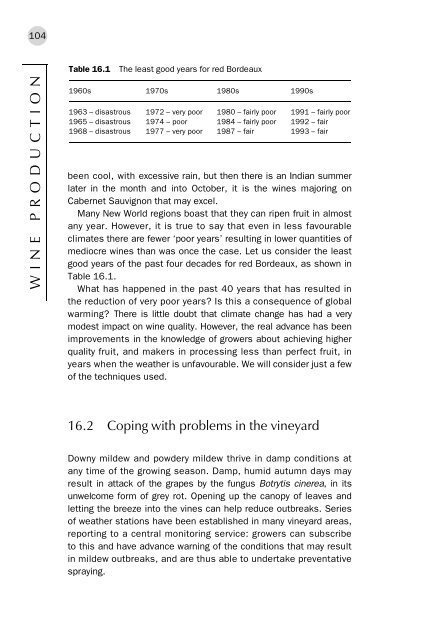Wine Production : Vine to Bottle - Vinum Vine
Wine Production : Vine to Bottle - Vinum Vine
Wine Production : Vine to Bottle - Vinum Vine
Create successful ePaper yourself
Turn your PDF publications into a flip-book with our unique Google optimized e-Paper software.
104<br />
Table 16.1<br />
The least good years for red Bordeaux<br />
WINE PRODUCTION<br />
1960s 1970s 1980s 1990s<br />
1963 – disastrous 1972 – very poor 1980 – fairly poor 1991 – fairly poor<br />
1965 – disastrous 1974 – poor 1984 – fairly poor 1992 – fair<br />
1968 – disastrous 1977 – very poor 1987 – fair 1993 – fair<br />
been cool, with excessive rain, but then there is an Indian summer<br />
later in the month and in<strong>to</strong> Oc<strong>to</strong>ber, it is the wines majoring on<br />
Cabernet Sauvignon that may excel.<br />
Many New World regions boast that they can ripen fruit in almost<br />
any year. However, it is true <strong>to</strong> say that even in less favourable<br />
climates there are fewer ‘poor years’ resulting in lower quantities of<br />
mediocre wines than was once the case. Let us consider the least<br />
good years of the past four decades for red Bordeaux, as shown in<br />
Table 16.1.<br />
What has happened in the past 40 years that has resulted in<br />
the reduction of very poor years Is this a consequence of global<br />
warming There is little doubt that climate change has had a very<br />
modest impact on wine quality. However, the real advance has been<br />
improvements in the knowledge of growers about achieving higher<br />
quality fruit, and makers in processing less than perfect fruit, in<br />
years when the weather is unfavourable. We will consider just a few<br />
of the techniques used.<br />
16.2 Coping with problems in the vineyard<br />
Downy mildew and powdery mildew thrive in damp conditions at<br />
any time of the growing season. Damp, humid autumn days may<br />
result in attack of the grapes by the fungus Botrytis cinerea, in its<br />
unwelcome form of grey rot. Opening up the canopy of leaves and<br />
letting the breeze in<strong>to</strong> the vines can help reduce outbreaks. Series<br />
of weather stations have been established in many vineyard areas,<br />
reporting <strong>to</strong> a central moni<strong>to</strong>ring service: growers can subscribe<br />
<strong>to</strong> this and have advance warning of the conditions that may result<br />
in mildew outbreaks, and are thus able <strong>to</strong> undertake preventative<br />
spraying.
















